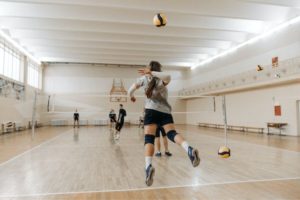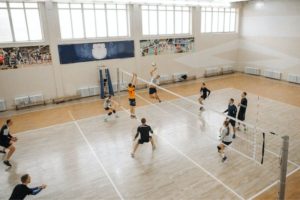Volleyball as a sport is very common both for recreational purposes and in competitive tournaments.
Its players require exceptional mental and physical capabilities, including speed, coordination, agility, and strategy. However, being pro at these can be challenging.

From the complex mechanism of the jump serve to split-second decision-making for blocking, volleyball offers unique challenges for its players.
Besides some players with natural talent, others will need to put much time and effort into developing their skills.
So whether you are a pro or a beginner trying to develop your skills, this article will provide valuable insights about the most challenging skills of volleyball.
5 Hardest Skills to Learn in Volleyball
The section will explore 5 of the most challenging volleyball skills and provide explanations and tips on how to develop them.
1. Jump Serving
This high-level volleyball technique requires a server to jump in mid-air and hit the ball more efficiently. It’s different from regular service.
In jump serving, servers serve from more heights and add more speed to the ball, making it quite difficult for opponents to return.
Mechanism of Jump serving
Jump serving has a complex mechanism. It requires the best body movement coordination to produce maximum power and accuracy.
The key components of jump serving include a well-balanced toss, good arm swing, and perfect contact with the ball.
How to Master Jump Serving in Volleyball
Mastering jump serve can be a challenging task, especially for newbies lacking strength and coordination. However, below are some tips and techniques that can effectively help you improve your jump serve.
- The most important prospect of a jump serve is its toss. It is the basis of the service. A poorly executed toss can ruin the complete service. For a perfect jump serve, practice toss and perfect your toss positioning.
- Another crucial component of a perfect jump serve is its approach. A strong approach generates the momentum requires to hit the ball with maximum power and accuracy, eventually making the serve undefeatable. Practicing the approach can help build muscle memory and effective technique.
- The importance of arm swing in jump serve is critical. A good arm swing generates maximum power and gives ultimate accuracy to the jump serve. For mastering jump serve, ensure to practice arm swing repeatedly.
2. Blocking
This volleyball skill is a defensive skill. It involves preventing the opponent team from hitting the ball across the net.
The most important factor of blocking is timing. A mistimed block eventually results in a point for the opponent team.
How to Develop Blocking In Volleyball

Developing good blocking techniques in volleyball can be challenging. From quick decision-making to reading the hitter’s movement, multiple factors make a block perfect. Below are some tips that can help you make your blocking exceptional:
- Judge the setter and hitter: Understanding the body movements of the opponent team’s setter and hitter is the most crucial point in blocking. Firstly, judge closely where the setter is tossing the ball and then judge the hitter’s approach and arm swing to see where they will hit the ball. This can help you adjust yourself accordingly.
- Jumping: Jumping is a basic process and does not require any specific mechanism. But practice jumping high and fast can make your jump perfect for blocking the ball. Furthermore, keep your hands above your head and wide open while jumping to cover the maximum area.
- Pressing over the ball: Once the opponent team’s hitter hits the ball, penetrate and press it when it is at the opponent’s side of the net. Try to press your hands and arms as much as you can, thus leaving no angle for the defender to retaliate.
- Communicate and coordinate: Communication and coordination are keys in any sport. Practice different types of blocking, that are single, double, and triple, with your teammates covering all the gaps between you.
- Practice: There is a common saying that practice makes a man perfect. This same rule applies to your blocking skill. Practice your skills in different situations and scenarios. Watch other players’ blocking skills and analyze their techniques. By doing this, you can eventually make your blocking perfect.
3. Setting in Transition
This volleyball skill involves a quick transition from your defensive position to your offensive position by letting your teammate attack.
Setting in transition is necessary to maintain your offensive approach. It allows you to catch opponents off guard and provide more opportunities to score points.
How to Improve Transition Skills in Volleyball
This skill is difficult to master as it requires quick decision-making, reflexes, and agility. However, below are some key areas players can focus on to improve their transition skills in volleyball.
Practicing footwork: Setting in transition requires quick movement across the volleyball court. Thus, excellent footwork skills are essential for transition.
Furthermore, practicing footwork drills boosts the player’s agility and speed and helps them change directions and stop quickly.
- Team Positioning: It’s important to manage your position depending on the ball’s trajectory. So a good distance among teammates avoids collision and confusion while setting in transition. Practice team positioning while playing small-sided games or scrimmages.
- Understand the opponent’s cues: Try to judge the cues from the opponent team’s body language. Notice their eyes, arms, and shoulders to predict where they will hit the ball. This can help you with a faster transition for the next play.
4. Defensive Footwork

In volleyball, defensive footwork is critical for effective defense. It includes quick and efficient moves to defend opponent team’s attacks.
A lack of good defensive footwork skills can cost players to miss crucial defensive opportunities and keep up with the game’s pace.
How to Improve Defensive Footwork Skills in Volleyball
Mastering defensive footwork skills can be challenging. This requires quick and speedy movement accordingly to the opponent team’s attack while maintaining the body’s balance and control.
However, below are some tips that can effectively help you improve your defensive footwork.
- Agility drills: Agility drills can help players improve their speed and reaction time, eventually leading to improved defensive footwork. Exercises like ladder and cone drills could effectively serve the purpose of agility drills.
- Work on body control: Body balance and control are crucial for good defensive footwork. Exercises like squats and lunges can help improve stability and strengthen legs, eventually improving speed and agility.
- Stay low: Staying low is an effective strategy to improve defensive footwork. Not only this helps in maintaining balance and control, but it also allows for fast movement to react more quickly to the opponent team’s attacks.
5. Hitting Placement
In volleyball, hitting placement is the ability to hit the ball on a specific point in the opponent team’s court. With the ultimate goal of making hits undefeatable, hitting placement is a crucial skill for offensive players.
How to Develop Hitting Placement in Volleyball
Precise timing and the ability to read the defense make it challenging to develop hitting placement. Players have to identify gaps and place their hits accordingly. However, some tips below can help you improve your hitting placement.
- Practice with a variety of sets: Practicing different types of sets, including high sets, low sets, and quick sets, can effectively help improve hitting placement. This also improves players’ ability to adjust their hitting placement accordingly with the type of set they receive.
- Practice hitting specific areas: The ultimate goal of hitting placement is to point scores. Corners and behind-the-blockers are the best points to hit the opponent team’s court. Thus practicing aiming to hit specific areas can improve hitting placement skills.
- Read the defense: Understanding the opponent team’s defense is crucial in hitting placement. Practice identifying gaps in the defense and hitting those gaps.
The Bottom Line
Volleyball is a challenging sport. It requires a combination of physical skills, mental focus, and strategic thinking. While many skills are required to ace the game, some are the most important and difficult.
These include jump serve, blocking, setting in transition, defensive footwork, and hitting placement.
By understanding the key requirements of these skills and by putting in their efforts and time, players can overcome the challenges and become more effective on the court.
Hard work and perseverance are the keys to mastering any volleyball skill.

When I was in high school, I was the best at running. Running for me is not a trend, this is my whole life. I jog every morning, without exceptions: I don’t skip mornings on vacations or business trips. My friends are also sports fans: I went to my best friend’s yoga class for the first time about three years ago.
Since then, I’ve been practicing regularly, and we have also made several yoga trips to India. For my last birthday, I got a skateboard as a present from her. Now we’re both taking personal classes with a coach, and it’s 100% fun!





